AstraZeneca: Project, Operations, and Systems Management Report
VerifiedAdded on 2019/09/20
|29
|9932
|490
Report
AI Summary
This report presents a comprehensive analysis of project, operations, and information systems management, focusing on a managerial challenge within AstraZeneca. The report includes an executive summary, a description of the managerial challenge, and the application of project management principles, including the Triple Constraint, project team, and Gantt chart with critical path. It also covers operations management improvements, information systems support, and the approach to measuring quality post-project. The assignment also includes the assignment of a project sponsor and team, the training needed, a work breakdown structure, a planning budget, and the use of project management software. The report emphasizes the importance of critical thinking, managerial decision-making, information literacy, problem-solving, systems thinking, and technology fluency. The provided example showcases a detailed project management plan, including stakeholder analysis, work breakdown structure, and schedule. The report also includes operations and information systems management plans to improve processes and efficiency.
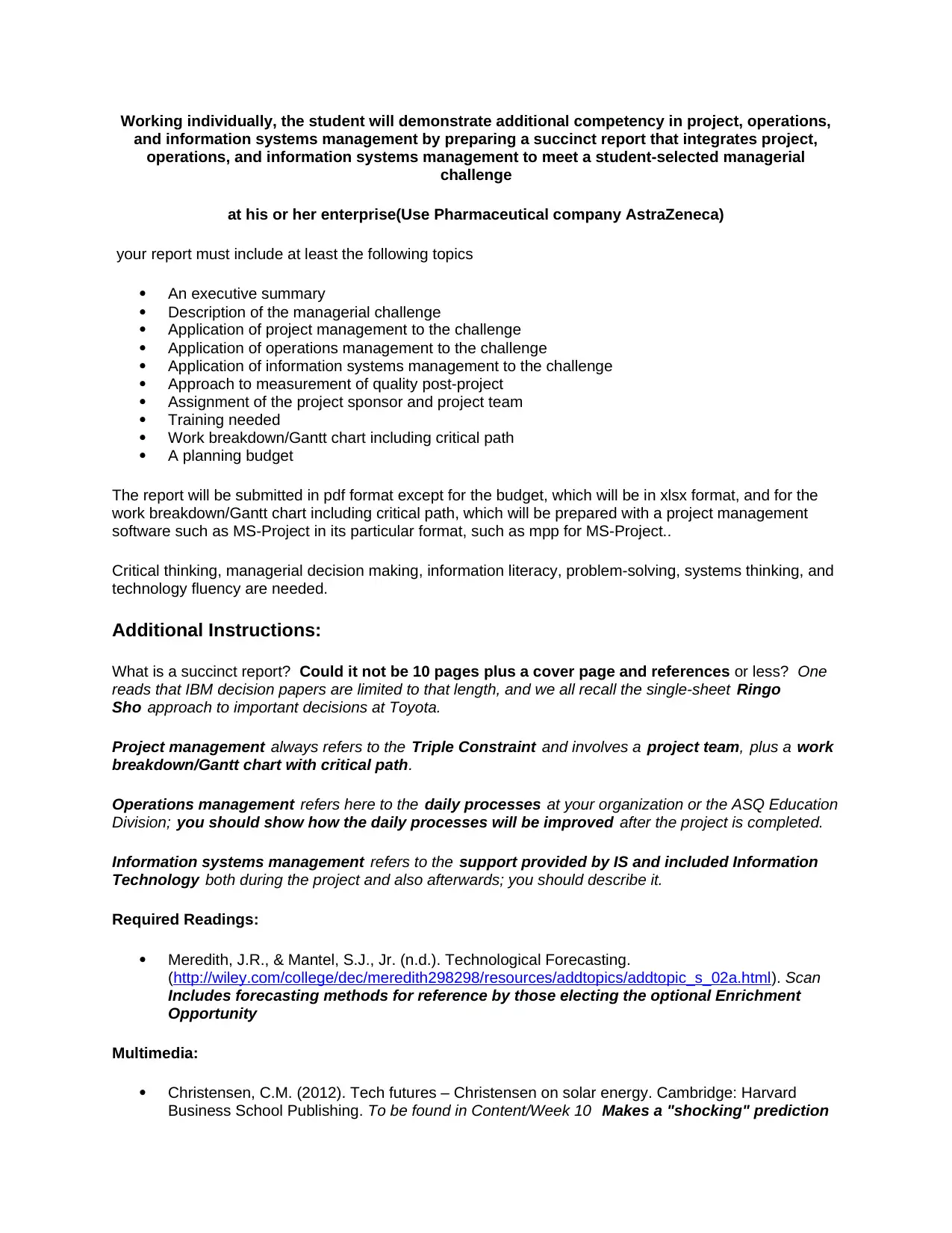
Working individually, the student will demonstrate additional competency in project, operations,
and information systems management by preparing a succinct report that integrates project,
operations, and information systems management to meet a student-selected managerial
challenge
at his or her enterprise(Use Pharmaceutical company AstraZeneca)
your report must include at least the following topics
An executive summary
Description of the managerial challenge
Application of project management to the challenge
Application of operations management to the challenge
Application of information systems management to the challenge
Approach to measurement of quality post-project
Assignment of the project sponsor and project team
Training needed
Work breakdown/Gantt chart including critical path
A planning budget
The report will be submitted in pdf format except for the budget, which will be in xlsx format, and for the
work breakdown/Gantt chart including critical path, which will be prepared with a project management
software such as MS-Project in its particular format, such as mpp for MS-Project..
Critical thinking, managerial decision making, information literacy, problem-solving, systems thinking, and
technology fluency are needed.
Additional Instructions:
What is a succinct report? Could it not be 10 pages plus a cover page and references or less? One
reads that IBM decision papers are limited to that length, and we all recall the single-sheet Ringo
Sho approach to important decisions at Toyota.
Project management always refers to the Triple Constraint and involves a project team, plus a work
breakdown/Gantt chart with critical path.
Operations management refers here to the daily processes at your organization or the ASQ Education
Division; you should show how the daily processes will be improved after the project is completed.
Information systems management refers to the support provided by IS and included Information
Technology both during the project and also afterwards; you should describe it.
Required Readings:
Meredith, J.R., & Mantel, S.J., Jr. (n.d.). Technological Forecasting.
(http://wiley.com/college/dec/meredith298298/resources/addtopics/addtopic_s_02a.html). Scan
Includes forecasting methods for reference by those electing the optional Enrichment
Opportunity
Multimedia:
Christensen, C.M. (2012). Tech futures – Christensen on solar energy. Cambridge: Harvard
Business School Publishing. To be found in Content/Week 10 Makes a "shocking" prediction
and information systems management by preparing a succinct report that integrates project,
operations, and information systems management to meet a student-selected managerial
challenge
at his or her enterprise(Use Pharmaceutical company AstraZeneca)
your report must include at least the following topics
An executive summary
Description of the managerial challenge
Application of project management to the challenge
Application of operations management to the challenge
Application of information systems management to the challenge
Approach to measurement of quality post-project
Assignment of the project sponsor and project team
Training needed
Work breakdown/Gantt chart including critical path
A planning budget
The report will be submitted in pdf format except for the budget, which will be in xlsx format, and for the
work breakdown/Gantt chart including critical path, which will be prepared with a project management
software such as MS-Project in its particular format, such as mpp for MS-Project..
Critical thinking, managerial decision making, information literacy, problem-solving, systems thinking, and
technology fluency are needed.
Additional Instructions:
What is a succinct report? Could it not be 10 pages plus a cover page and references or less? One
reads that IBM decision papers are limited to that length, and we all recall the single-sheet Ringo
Sho approach to important decisions at Toyota.
Project management always refers to the Triple Constraint and involves a project team, plus a work
breakdown/Gantt chart with critical path.
Operations management refers here to the daily processes at your organization or the ASQ Education
Division; you should show how the daily processes will be improved after the project is completed.
Information systems management refers to the support provided by IS and included Information
Technology both during the project and also afterwards; you should describe it.
Required Readings:
Meredith, J.R., & Mantel, S.J., Jr. (n.d.). Technological Forecasting.
(http://wiley.com/college/dec/meredith298298/resources/addtopics/addtopic_s_02a.html). Scan
Includes forecasting methods for reference by those electing the optional Enrichment
Opportunity
Multimedia:
Christensen, C.M. (2012). Tech futures – Christensen on solar energy. Cambridge: Harvard
Business School Publishing. To be found in Content/Week 10 Makes a "shocking" prediction
Paraphrase This Document
Need a fresh take? Get an instant paraphrase of this document with our AI Paraphraser
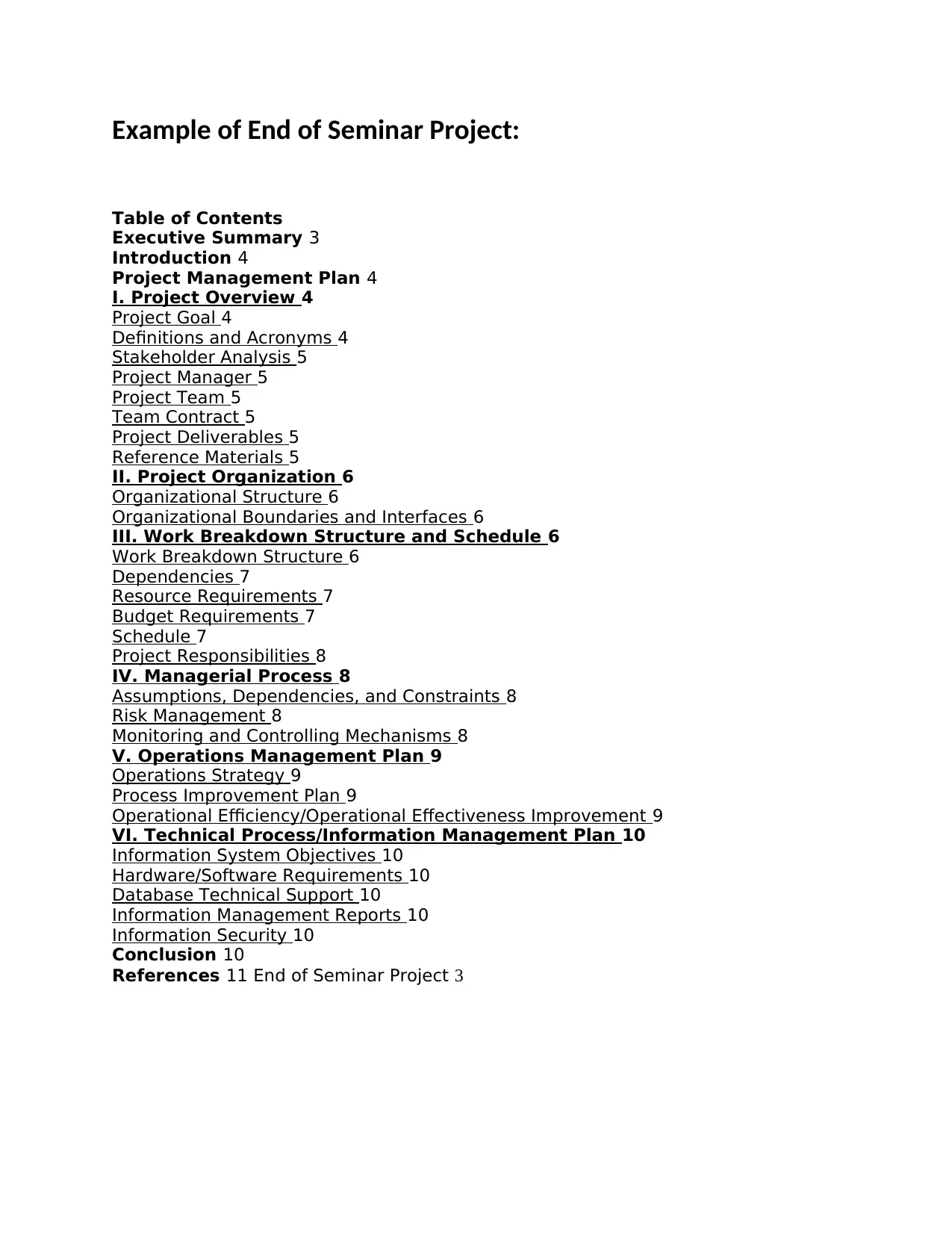
Example of End of Seminar Project:
Table of Contents
Executive Summary 3
Introduction 4
Project Management Plan 4
I. Project Overview 4
Project Goal 4
Definitions and Acronyms 4
Stakeholder Analysis 5
Project Manager 5
Project Team 5
Team Contract 5
Project Deliverables 5
Reference Materials 5
II. Project Organization 6
Organizational Structure 6
Organizational Boundaries and Interfaces 6
III. Work Breakdown Structure and Schedule 6
Work Breakdown Structure 6
Dependencies 7
Resource Requirements 7
Budget Requirements 7
Schedule 7
Project Responsibilities 8
IV. Managerial Process 8
Assumptions, Dependencies, and Constraints 8
Risk Management 8
Monitoring and Controlling Mechanisms 8
V. Operations Management Plan 9
Operations Strategy 9
Process Improvement Plan 9
Operational Efficiency/Operational Effectiveness Improvement 9
VI. Technical Process/Information Management Plan 10
Information System Objectives 10
Hardware/Software Requirements 10
Database Technical Support 10
Information Management Reports 10
Information Security 10
Conclusion 10
References 11 End of Seminar Project 3
Table of Contents
Executive Summary 3
Introduction 4
Project Management Plan 4
I. Project Overview 4
Project Goal 4
Definitions and Acronyms 4
Stakeholder Analysis 5
Project Manager 5
Project Team 5
Team Contract 5
Project Deliverables 5
Reference Materials 5
II. Project Organization 6
Organizational Structure 6
Organizational Boundaries and Interfaces 6
III. Work Breakdown Structure and Schedule 6
Work Breakdown Structure 6
Dependencies 7
Resource Requirements 7
Budget Requirements 7
Schedule 7
Project Responsibilities 8
IV. Managerial Process 8
Assumptions, Dependencies, and Constraints 8
Risk Management 8
Monitoring and Controlling Mechanisms 8
V. Operations Management Plan 9
Operations Strategy 9
Process Improvement Plan 9
Operational Efficiency/Operational Effectiveness Improvement 9
VI. Technical Process/Information Management Plan 10
Information System Objectives 10
Hardware/Software Requirements 10
Database Technical Support 10
Information Management Reports 10
Information Security 10
Conclusion 10
References 11 End of Seminar Project 3
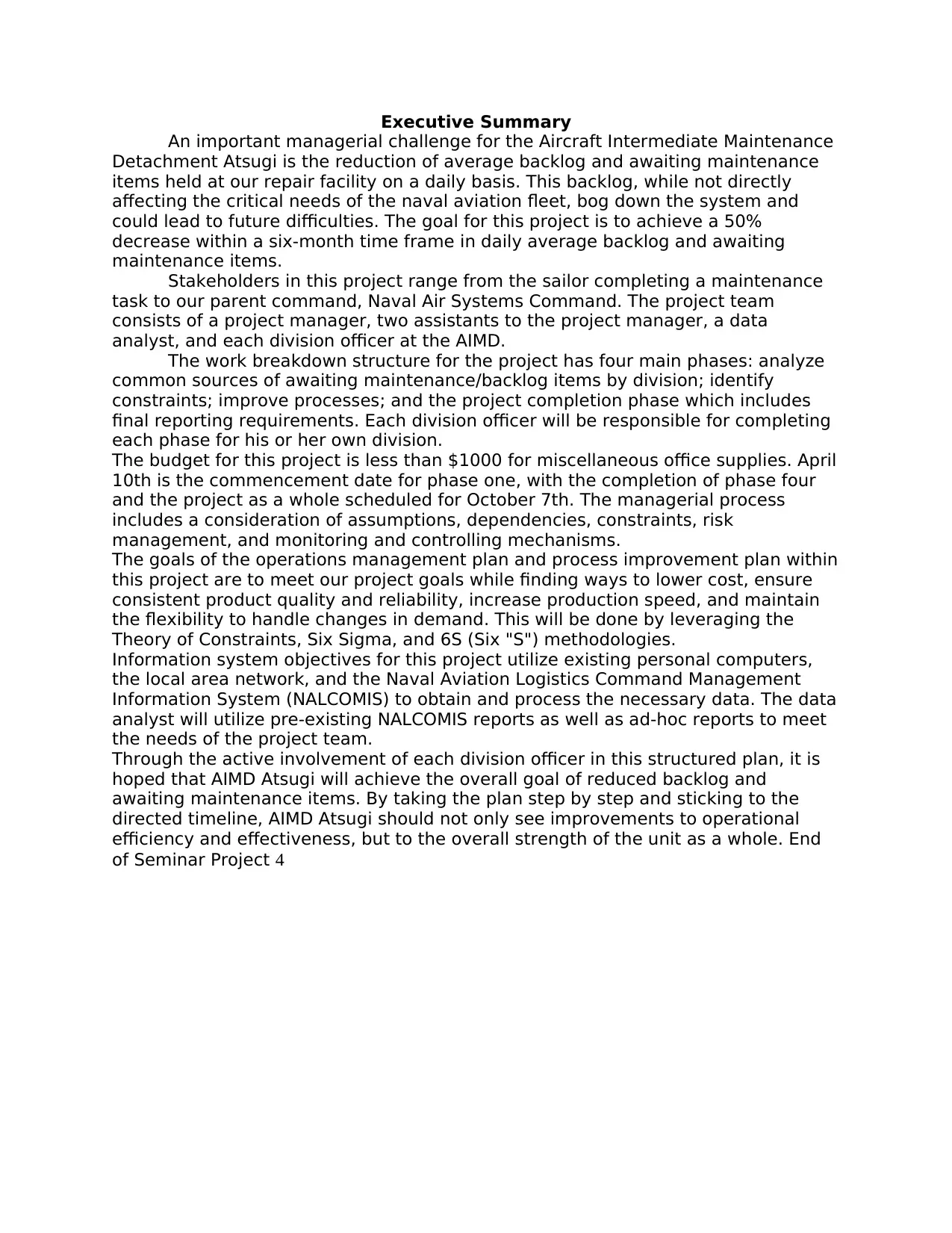
Executive Summary
An important managerial challenge for the Aircraft Intermediate Maintenance
Detachment Atsugi is the reduction of average backlog and awaiting maintenance
items held at our repair facility on a daily basis. This backlog, while not directly
affecting the critical needs of the naval aviation fleet, bog down the system and
could lead to future difficulties. The goal for this project is to achieve a 50%
decrease within a six-month time frame in daily average backlog and awaiting
maintenance items.
Stakeholders in this project range from the sailor completing a maintenance
task to our parent command, Naval Air Systems Command. The project team
consists of a project manager, two assistants to the project manager, a data
analyst, and each division officer at the AIMD.
The work breakdown structure for the project has four main phases: analyze
common sources of awaiting maintenance/backlog items by division; identify
constraints; improve processes; and the project completion phase which includes
final reporting requirements. Each division officer will be responsible for completing
each phase for his or her own division.
The budget for this project is less than $1000 for miscellaneous office supplies. April
10th is the commencement date for phase one, with the completion of phase four
and the project as a whole scheduled for October 7th. The managerial process
includes a consideration of assumptions, dependencies, constraints, risk
management, and monitoring and controlling mechanisms.
The goals of the operations management plan and process improvement plan within
this project are to meet our project goals while finding ways to lower cost, ensure
consistent product quality and reliability, increase production speed, and maintain
the flexibility to handle changes in demand. This will be done by leveraging the
Theory of Constraints, Six Sigma, and 6S (Six "S") methodologies.
Information system objectives for this project utilize existing personal computers,
the local area network, and the Naval Aviation Logistics Command Management
Information System (NALCOMIS) to obtain and process the necessary data. The data
analyst will utilize pre-existing NALCOMIS reports as well as ad-hoc reports to meet
the needs of the project team.
Through the active involvement of each division officer in this structured plan, it is
hoped that AIMD Atsugi will achieve the overall goal of reduced backlog and
awaiting maintenance items. By taking the plan step by step and sticking to the
directed timeline, AIMD Atsugi should not only see improvements to operational
efficiency and effectiveness, but to the overall strength of the unit as a whole. End
of Seminar Project 4
An important managerial challenge for the Aircraft Intermediate Maintenance
Detachment Atsugi is the reduction of average backlog and awaiting maintenance
items held at our repair facility on a daily basis. This backlog, while not directly
affecting the critical needs of the naval aviation fleet, bog down the system and
could lead to future difficulties. The goal for this project is to achieve a 50%
decrease within a six-month time frame in daily average backlog and awaiting
maintenance items.
Stakeholders in this project range from the sailor completing a maintenance
task to our parent command, Naval Air Systems Command. The project team
consists of a project manager, two assistants to the project manager, a data
analyst, and each division officer at the AIMD.
The work breakdown structure for the project has four main phases: analyze
common sources of awaiting maintenance/backlog items by division; identify
constraints; improve processes; and the project completion phase which includes
final reporting requirements. Each division officer will be responsible for completing
each phase for his or her own division.
The budget for this project is less than $1000 for miscellaneous office supplies. April
10th is the commencement date for phase one, with the completion of phase four
and the project as a whole scheduled for October 7th. The managerial process
includes a consideration of assumptions, dependencies, constraints, risk
management, and monitoring and controlling mechanisms.
The goals of the operations management plan and process improvement plan within
this project are to meet our project goals while finding ways to lower cost, ensure
consistent product quality and reliability, increase production speed, and maintain
the flexibility to handle changes in demand. This will be done by leveraging the
Theory of Constraints, Six Sigma, and 6S (Six "S") methodologies.
Information system objectives for this project utilize existing personal computers,
the local area network, and the Naval Aviation Logistics Command Management
Information System (NALCOMIS) to obtain and process the necessary data. The data
analyst will utilize pre-existing NALCOMIS reports as well as ad-hoc reports to meet
the needs of the project team.
Through the active involvement of each division officer in this structured plan, it is
hoped that AIMD Atsugi will achieve the overall goal of reduced backlog and
awaiting maintenance items. By taking the plan step by step and sticking to the
directed timeline, AIMD Atsugi should not only see improvements to operational
efficiency and effectiveness, but to the overall strength of the unit as a whole. End
of Seminar Project 4
⊘ This is a preview!⊘
Do you want full access?
Subscribe today to unlock all pages.

Trusted by 1+ million students worldwide
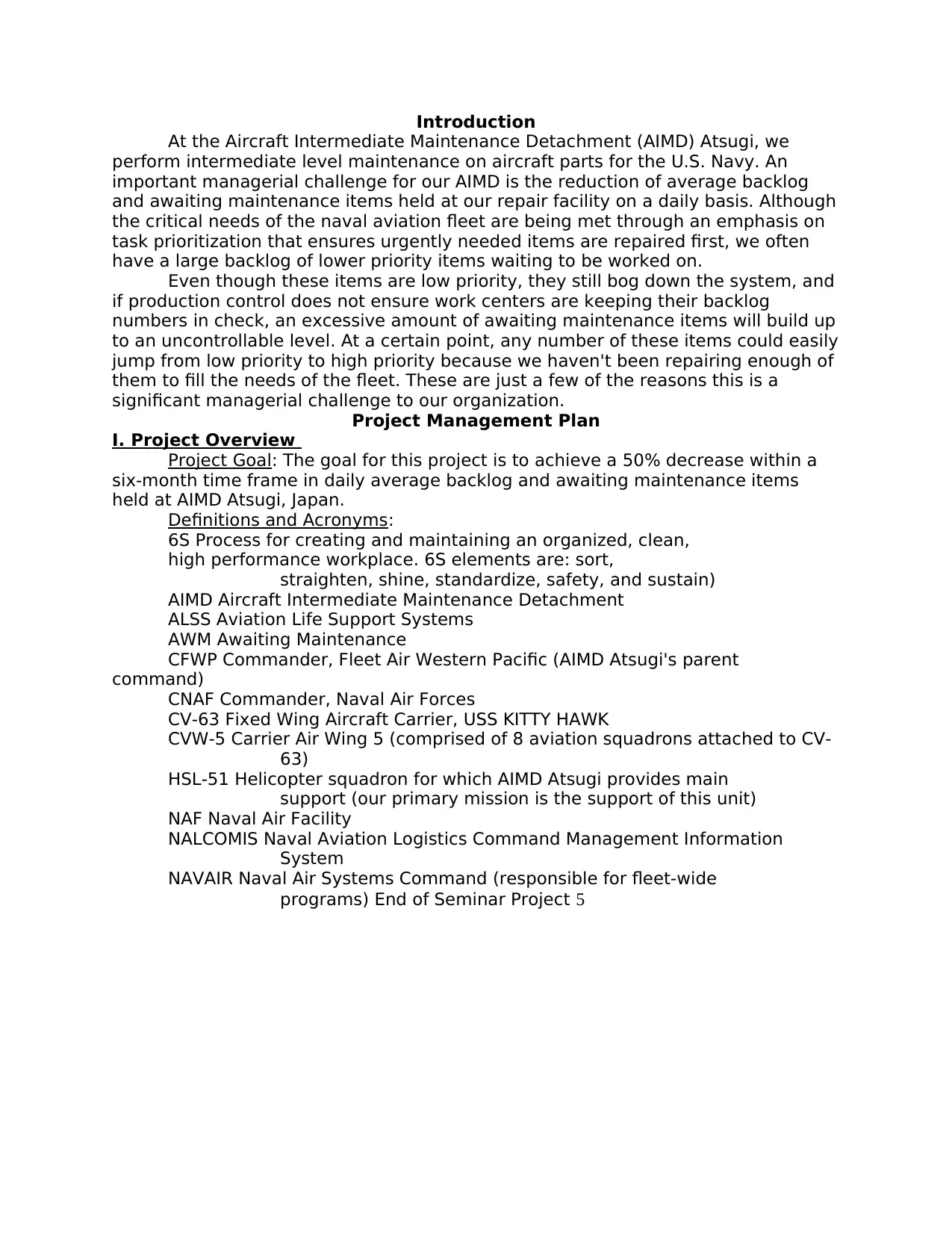
Introduction
At the Aircraft Intermediate Maintenance Detachment (AIMD) Atsugi, we
perform intermediate level maintenance on aircraft parts for the U.S. Navy. An
important managerial challenge for our AIMD is the reduction of average backlog
and awaiting maintenance items held at our repair facility on a daily basis. Although
the critical needs of the naval aviation fleet are being met through an emphasis on
task prioritization that ensures urgently needed items are repaired first, we often
have a large backlog of lower priority items waiting to be worked on.
Even though these items are low priority, they still bog down the system, and
if production control does not ensure work centers are keeping their backlog
numbers in check, an excessive amount of awaiting maintenance items will build up
to an uncontrollable level. At a certain point, any number of these items could easily
jump from low priority to high priority because we haven't been repairing enough of
them to fill the needs of the fleet. These are just a few of the reasons this is a
significant managerial challenge to our organization.
Project Management Plan
I. Project Overview
Project Goal: The goal for this project is to achieve a 50% decrease within a
six-month time frame in daily average backlog and awaiting maintenance items
held at AIMD Atsugi, Japan.
Definitions and Acronyms:
6S Process for creating and maintaining an organized, clean,
high performance workplace. 6S elements are: sort,
straighten, shine, standardize, safety, and sustain)
AIMD Aircraft Intermediate Maintenance Detachment
ALSS Aviation Life Support Systems
AWM Awaiting Maintenance
CFWP Commander, Fleet Air Western Pacific (AIMD Atsugi's parent
command)
CNAF Commander, Naval Air Forces
CV-63 Fixed Wing Aircraft Carrier, USS KITTY HAWK
CVW-5 Carrier Air Wing 5 (comprised of 8 aviation squadrons attached to CV-
63)
HSL-51 Helicopter squadron for which AIMD Atsugi provides main
support (our primary mission is the support of this unit)
NAF Naval Air Facility
NALCOMIS Naval Aviation Logistics Command Management Information
System
NAVAIR Naval Air Systems Command (responsible for fleet-wide
programs) End of Seminar Project 5
At the Aircraft Intermediate Maintenance Detachment (AIMD) Atsugi, we
perform intermediate level maintenance on aircraft parts for the U.S. Navy. An
important managerial challenge for our AIMD is the reduction of average backlog
and awaiting maintenance items held at our repair facility on a daily basis. Although
the critical needs of the naval aviation fleet are being met through an emphasis on
task prioritization that ensures urgently needed items are repaired first, we often
have a large backlog of lower priority items waiting to be worked on.
Even though these items are low priority, they still bog down the system, and
if production control does not ensure work centers are keeping their backlog
numbers in check, an excessive amount of awaiting maintenance items will build up
to an uncontrollable level. At a certain point, any number of these items could easily
jump from low priority to high priority because we haven't been repairing enough of
them to fill the needs of the fleet. These are just a few of the reasons this is a
significant managerial challenge to our organization.
Project Management Plan
I. Project Overview
Project Goal: The goal for this project is to achieve a 50% decrease within a
six-month time frame in daily average backlog and awaiting maintenance items
held at AIMD Atsugi, Japan.
Definitions and Acronyms:
6S Process for creating and maintaining an organized, clean,
high performance workplace. 6S elements are: sort,
straighten, shine, standardize, safety, and sustain)
AIMD Aircraft Intermediate Maintenance Detachment
ALSS Aviation Life Support Systems
AWM Awaiting Maintenance
CFWP Commander, Fleet Air Western Pacific (AIMD Atsugi's parent
command)
CNAF Commander, Naval Air Forces
CV-63 Fixed Wing Aircraft Carrier, USS KITTY HAWK
CVW-5 Carrier Air Wing 5 (comprised of 8 aviation squadrons attached to CV-
63)
HSL-51 Helicopter squadron for which AIMD Atsugi provides main
support (our primary mission is the support of this unit)
NAF Naval Air Facility
NALCOMIS Naval Aviation Logistics Command Management Information
System
NAVAIR Naval Air Systems Command (responsible for fleet-wide
programs) End of Seminar Project 5
Paraphrase This Document
Need a fresh take? Get an instant paraphrase of this document with our AI Paraphraser
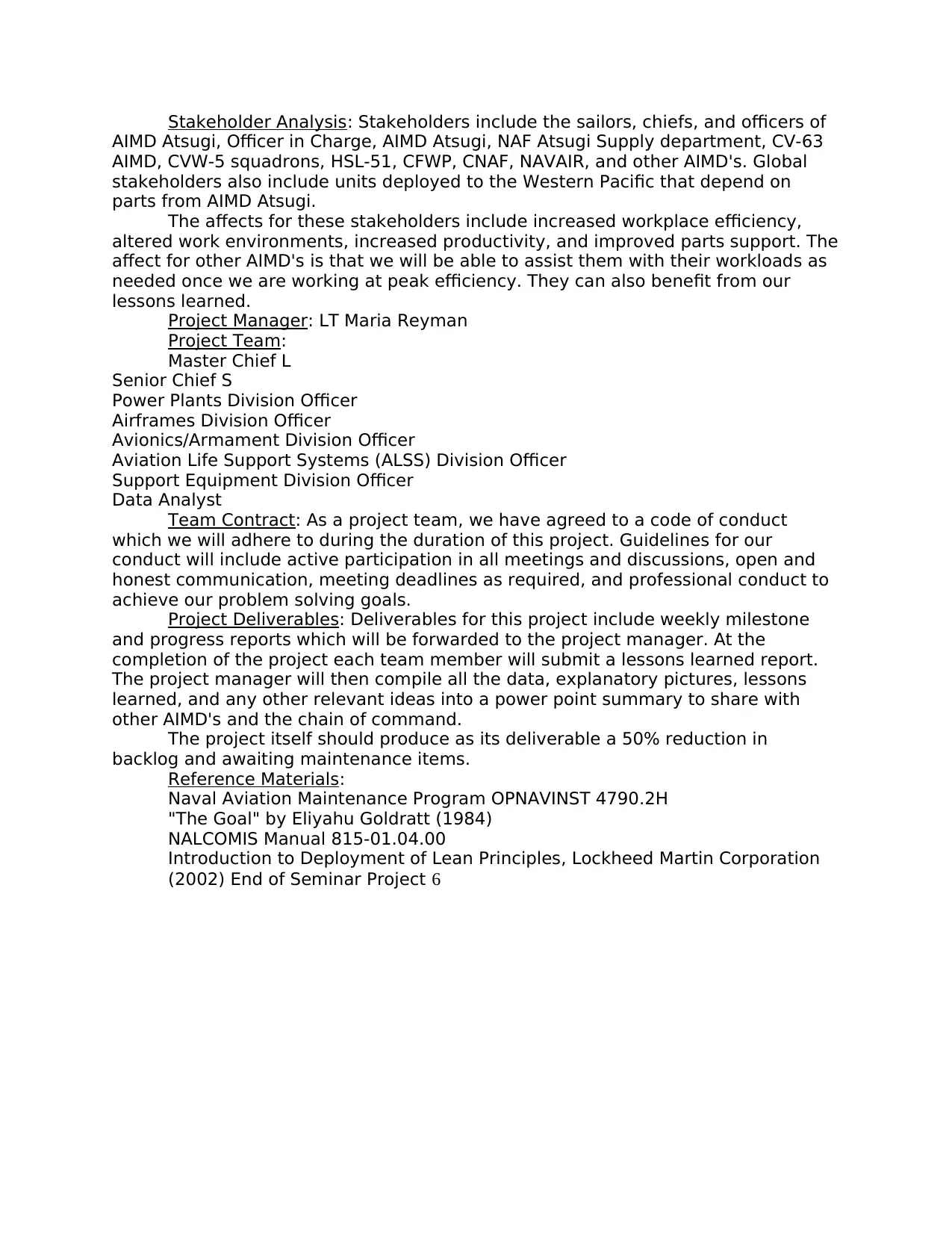
Stakeholder Analysis: Stakeholders include the sailors, chiefs, and officers of
AIMD Atsugi, Officer in Charge, AIMD Atsugi, NAF Atsugi Supply department, CV-63
AIMD, CVW-5 squadrons, HSL-51, CFWP, CNAF, NAVAIR, and other AIMD's. Global
stakeholders also include units deployed to the Western Pacific that depend on
parts from AIMD Atsugi.
The affects for these stakeholders include increased workplace efficiency,
altered work environments, increased productivity, and improved parts support. The
affect for other AIMD's is that we will be able to assist them with their workloads as
needed once we are working at peak efficiency. They can also benefit from our
lessons learned.
Project Manager: LT Maria Reyman
Project Team:
Master Chief L
Senior Chief S
Power Plants Division Officer
Airframes Division Officer
Avionics/Armament Division Officer
Aviation Life Support Systems (ALSS) Division Officer
Support Equipment Division Officer
Data Analyst
Team Contract: As a project team, we have agreed to a code of conduct
which we will adhere to during the duration of this project. Guidelines for our
conduct will include active participation in all meetings and discussions, open and
honest communication, meeting deadlines as required, and professional conduct to
achieve our problem solving goals.
Project Deliverables: Deliverables for this project include weekly milestone
and progress reports which will be forwarded to the project manager. At the
completion of the project each team member will submit a lessons learned report.
The project manager will then compile all the data, explanatory pictures, lessons
learned, and any other relevant ideas into a power point summary to share with
other AIMD's and the chain of command.
The project itself should produce as its deliverable a 50% reduction in
backlog and awaiting maintenance items.
Reference Materials:
Naval Aviation Maintenance Program OPNAVINST 4790.2H
"The Goal" by Eliyahu Goldratt (1984)
NALCOMIS Manual 815-01.04.00
Introduction to Deployment of Lean Principles, Lockheed Martin Corporation
(2002) End of Seminar Project 6
AIMD Atsugi, Officer in Charge, AIMD Atsugi, NAF Atsugi Supply department, CV-63
AIMD, CVW-5 squadrons, HSL-51, CFWP, CNAF, NAVAIR, and other AIMD's. Global
stakeholders also include units deployed to the Western Pacific that depend on
parts from AIMD Atsugi.
The affects for these stakeholders include increased workplace efficiency,
altered work environments, increased productivity, and improved parts support. The
affect for other AIMD's is that we will be able to assist them with their workloads as
needed once we are working at peak efficiency. They can also benefit from our
lessons learned.
Project Manager: LT Maria Reyman
Project Team:
Master Chief L
Senior Chief S
Power Plants Division Officer
Airframes Division Officer
Avionics/Armament Division Officer
Aviation Life Support Systems (ALSS) Division Officer
Support Equipment Division Officer
Data Analyst
Team Contract: As a project team, we have agreed to a code of conduct
which we will adhere to during the duration of this project. Guidelines for our
conduct will include active participation in all meetings and discussions, open and
honest communication, meeting deadlines as required, and professional conduct to
achieve our problem solving goals.
Project Deliverables: Deliverables for this project include weekly milestone
and progress reports which will be forwarded to the project manager. At the
completion of the project each team member will submit a lessons learned report.
The project manager will then compile all the data, explanatory pictures, lessons
learned, and any other relevant ideas into a power point summary to share with
other AIMD's and the chain of command.
The project itself should produce as its deliverable a 50% reduction in
backlog and awaiting maintenance items.
Reference Materials:
Naval Aviation Maintenance Program OPNAVINST 4790.2H
"The Goal" by Eliyahu Goldratt (1984)
NALCOMIS Manual 815-01.04.00
Introduction to Deployment of Lean Principles, Lockheed Martin Corporation
(2002) End of Seminar Project 6
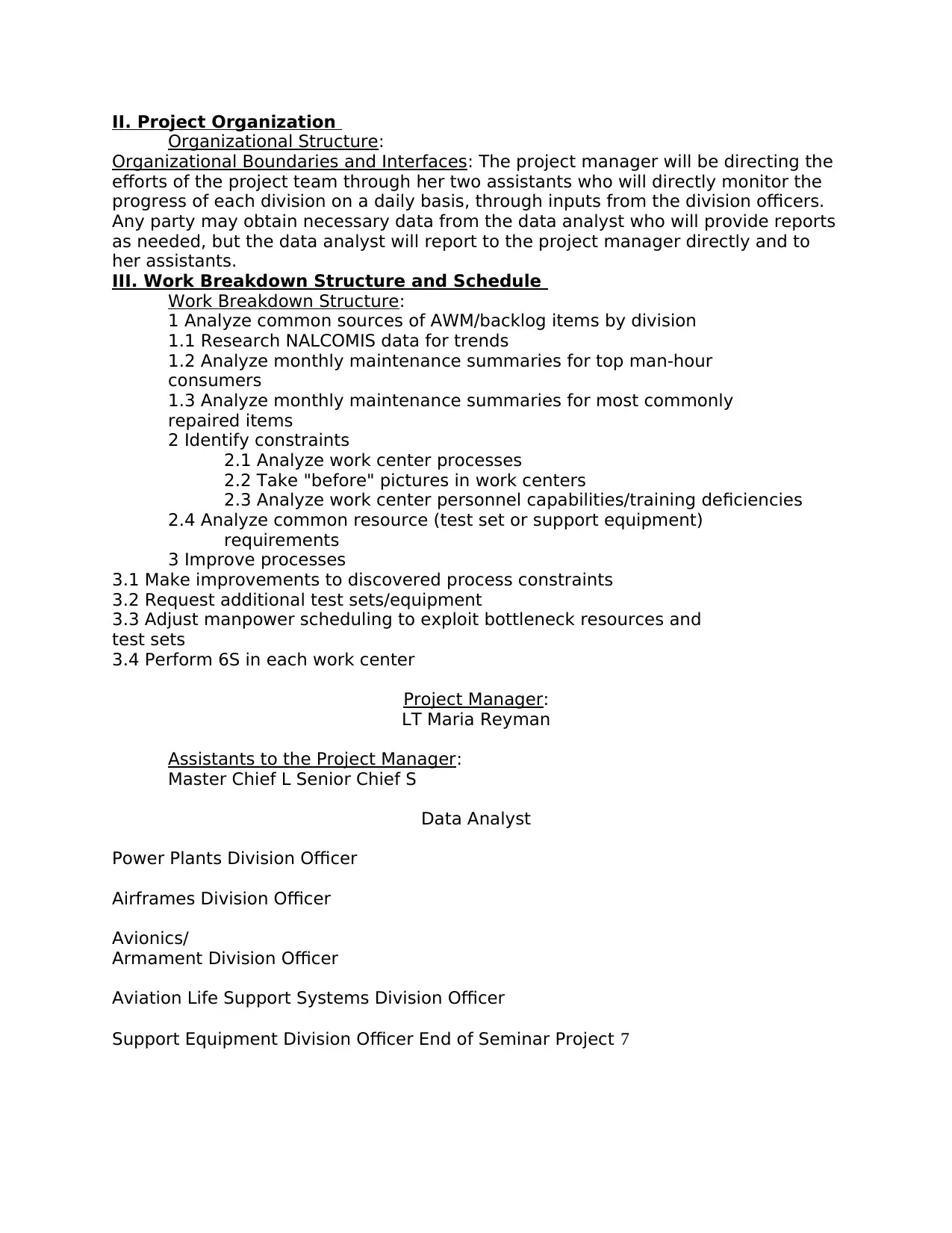
II. Project Organization
Organizational Structure:
Organizational Boundaries and Interfaces: The project manager will be directing the
efforts of the project team through her two assistants who will directly monitor the
progress of each division on a daily basis, through inputs from the division officers.
Any party may obtain necessary data from the data analyst who will provide reports
as needed, but the data analyst will report to the project manager directly and to
her assistants.
III. Work Breakdown Structure and Schedule
Work Breakdown Structure:
1 Analyze common sources of AWM/backlog items by division
1.1 Research NALCOMIS data for trends
1.2 Analyze monthly maintenance summaries for top man-hour
consumers
1.3 Analyze monthly maintenance summaries for most commonly
repaired items
2 Identify constraints
2.1 Analyze work center processes
2.2 Take "before" pictures in work centers
2.3 Analyze work center personnel capabilities/training deficiencies
2.4 Analyze common resource (test set or support equipment)
requirements
3 Improve processes
3.1 Make improvements to discovered process constraints
3.2 Request additional test sets/equipment
3.3 Adjust manpower scheduling to exploit bottleneck resources and
test sets
3.4 Perform 6S in each work center
Project Manager:
LT Maria Reyman
Assistants to the Project Manager:
Master Chief L Senior Chief S
Data Analyst
Power Plants Division Officer
Airframes Division Officer
Avionics/
Armament Division Officer
Aviation Life Support Systems Division Officer
Support Equipment Division Officer End of Seminar Project 7
Organizational Structure:
Organizational Boundaries and Interfaces: The project manager will be directing the
efforts of the project team through her two assistants who will directly monitor the
progress of each division on a daily basis, through inputs from the division officers.
Any party may obtain necessary data from the data analyst who will provide reports
as needed, but the data analyst will report to the project manager directly and to
her assistants.
III. Work Breakdown Structure and Schedule
Work Breakdown Structure:
1 Analyze common sources of AWM/backlog items by division
1.1 Research NALCOMIS data for trends
1.2 Analyze monthly maintenance summaries for top man-hour
consumers
1.3 Analyze monthly maintenance summaries for most commonly
repaired items
2 Identify constraints
2.1 Analyze work center processes
2.2 Take "before" pictures in work centers
2.3 Analyze work center personnel capabilities/training deficiencies
2.4 Analyze common resource (test set or support equipment)
requirements
3 Improve processes
3.1 Make improvements to discovered process constraints
3.2 Request additional test sets/equipment
3.3 Adjust manpower scheduling to exploit bottleneck resources and
test sets
3.4 Perform 6S in each work center
Project Manager:
LT Maria Reyman
Assistants to the Project Manager:
Master Chief L Senior Chief S
Data Analyst
Power Plants Division Officer
Airframes Division Officer
Avionics/
Armament Division Officer
Aviation Life Support Systems Division Officer
Support Equipment Division Officer End of Seminar Project 7
⊘ This is a preview!⊘
Do you want full access?
Subscribe today to unlock all pages.

Trusted by 1+ million students worldwide
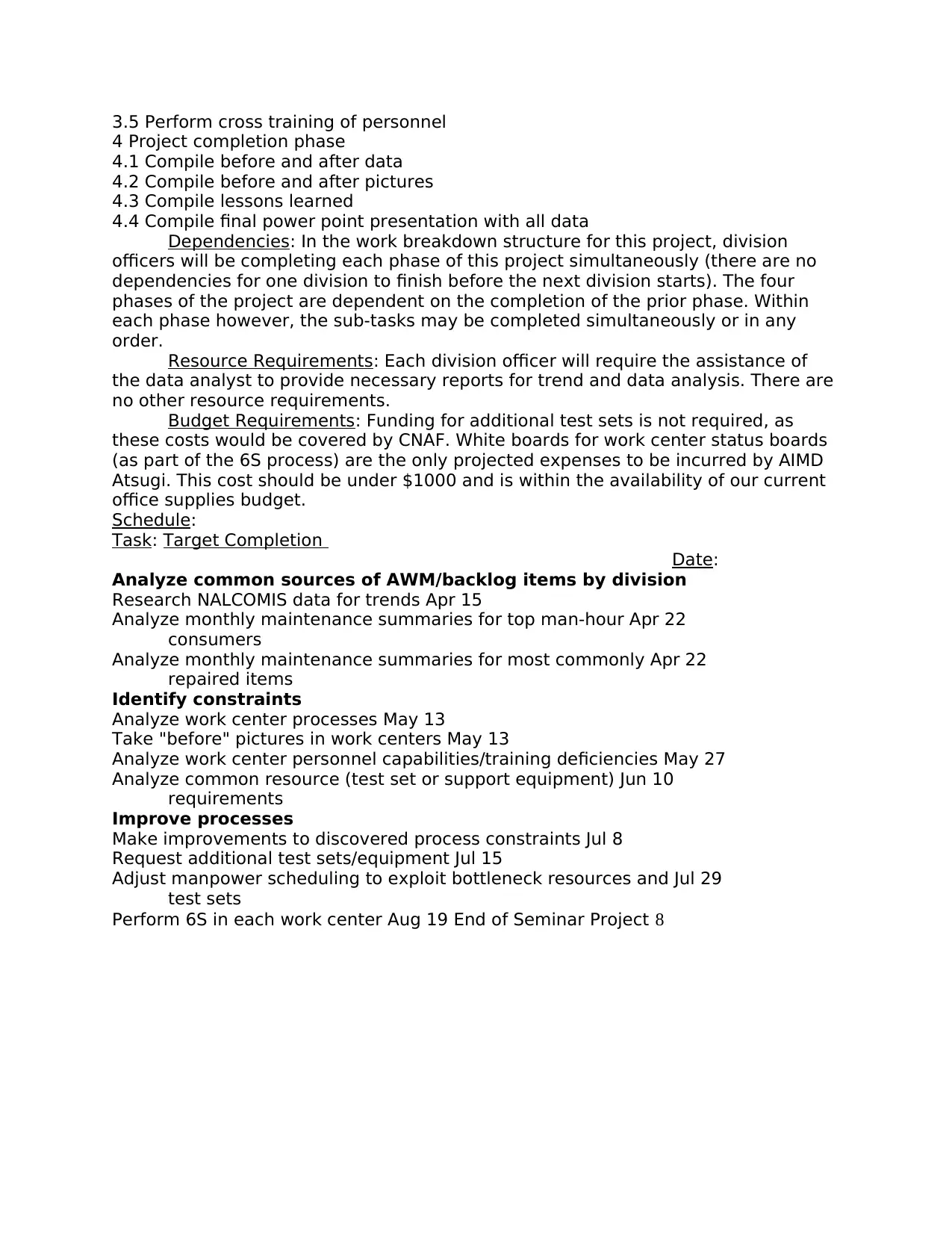
3.5 Perform cross training of personnel
4 Project completion phase
4.1 Compile before and after data
4.2 Compile before and after pictures
4.3 Compile lessons learned
4.4 Compile final power point presentation with all data
Dependencies: In the work breakdown structure for this project, division
officers will be completing each phase of this project simultaneously (there are no
dependencies for one division to finish before the next division starts). The four
phases of the project are dependent on the completion of the prior phase. Within
each phase however, the sub-tasks may be completed simultaneously or in any
order.
Resource Requirements: Each division officer will require the assistance of
the data analyst to provide necessary reports for trend and data analysis. There are
no other resource requirements.
Budget Requirements: Funding for additional test sets is not required, as
these costs would be covered by CNAF. White boards for work center status boards
(as part of the 6S process) are the only projected expenses to be incurred by AIMD
Atsugi. This cost should be under $1000 and is within the availability of our current
office supplies budget.
Schedule:
Task: Target Completion
Date:
Analyze common sources of AWM/backlog items by division
Research NALCOMIS data for trends Apr 15
Analyze monthly maintenance summaries for top man-hour Apr 22
consumers
Analyze monthly maintenance summaries for most commonly Apr 22
repaired items
Identify constraints
Analyze work center processes May 13
Take "before" pictures in work centers May 13
Analyze work center personnel capabilities/training deficiencies May 27
Analyze common resource (test set or support equipment) Jun 10
requirements
Improve processes
Make improvements to discovered process constraints Jul 8
Request additional test sets/equipment Jul 15
Adjust manpower scheduling to exploit bottleneck resources and Jul 29
test sets
Perform 6S in each work center Aug 19 End of Seminar Project 8
4 Project completion phase
4.1 Compile before and after data
4.2 Compile before and after pictures
4.3 Compile lessons learned
4.4 Compile final power point presentation with all data
Dependencies: In the work breakdown structure for this project, division
officers will be completing each phase of this project simultaneously (there are no
dependencies for one division to finish before the next division starts). The four
phases of the project are dependent on the completion of the prior phase. Within
each phase however, the sub-tasks may be completed simultaneously or in any
order.
Resource Requirements: Each division officer will require the assistance of
the data analyst to provide necessary reports for trend and data analysis. There are
no other resource requirements.
Budget Requirements: Funding for additional test sets is not required, as
these costs would be covered by CNAF. White boards for work center status boards
(as part of the 6S process) are the only projected expenses to be incurred by AIMD
Atsugi. This cost should be under $1000 and is within the availability of our current
office supplies budget.
Schedule:
Task: Target Completion
Date:
Analyze common sources of AWM/backlog items by division
Research NALCOMIS data for trends Apr 15
Analyze monthly maintenance summaries for top man-hour Apr 22
consumers
Analyze monthly maintenance summaries for most commonly Apr 22
repaired items
Identify constraints
Analyze work center processes May 13
Take "before" pictures in work centers May 13
Analyze work center personnel capabilities/training deficiencies May 27
Analyze common resource (test set or support equipment) Jun 10
requirements
Improve processes
Make improvements to discovered process constraints Jul 8
Request additional test sets/equipment Jul 15
Adjust manpower scheduling to exploit bottleneck resources and Jul 29
test sets
Perform 6S in each work center Aug 19 End of Seminar Project 8
Paraphrase This Document
Need a fresh take? Get an instant paraphrase of this document with our AI Paraphraser
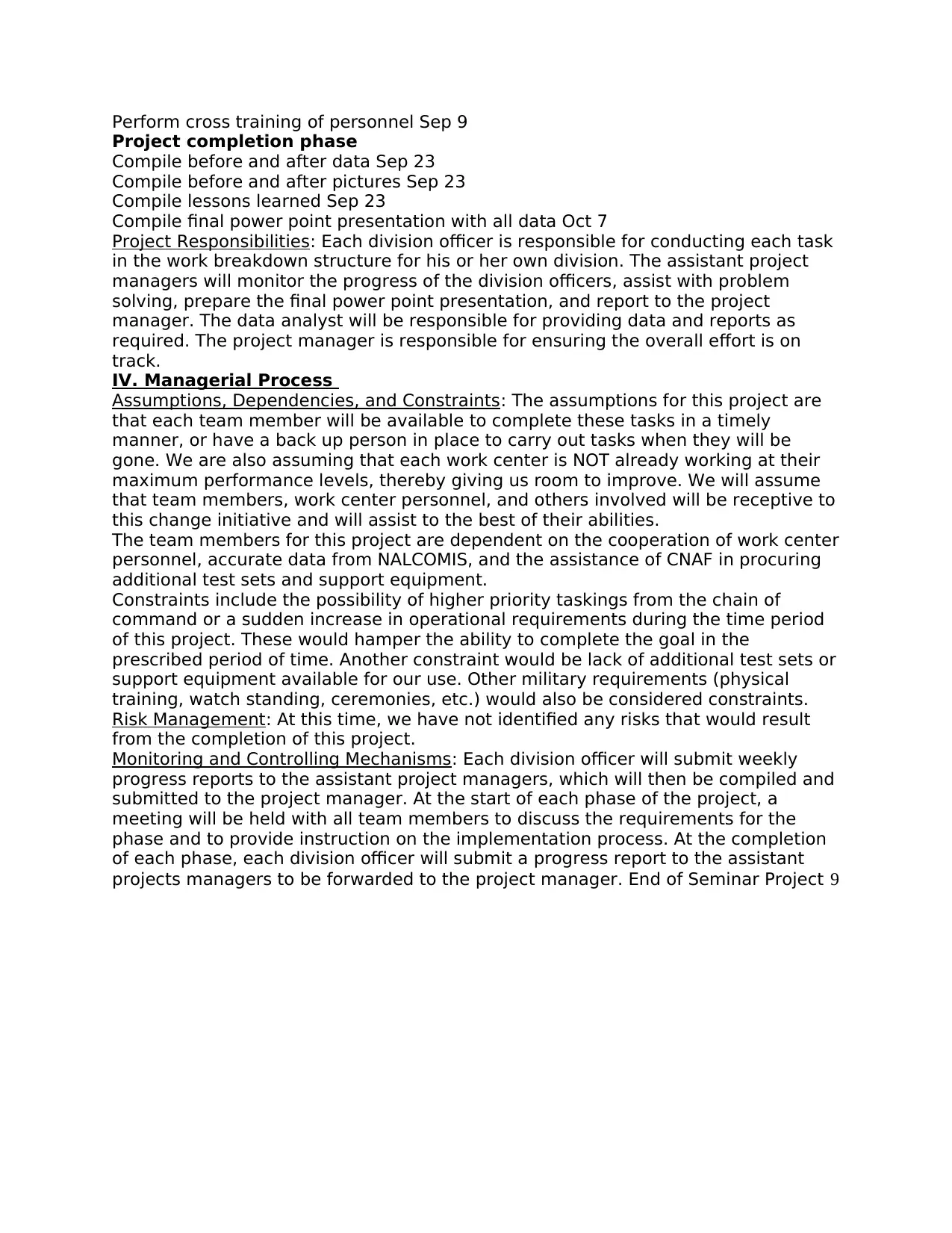
Perform cross training of personnel Sep 9
Project completion phase
Compile before and after data Sep 23
Compile before and after pictures Sep 23
Compile lessons learned Sep 23
Compile final power point presentation with all data Oct 7
Project Responsibilities: Each division officer is responsible for conducting each task
in the work breakdown structure for his or her own division. The assistant project
managers will monitor the progress of the division officers, assist with problem
solving, prepare the final power point presentation, and report to the project
manager. The data analyst will be responsible for providing data and reports as
required. The project manager is responsible for ensuring the overall effort is on
track.
IV. Managerial Process
Assumptions, Dependencies, and Constraints: The assumptions for this project are
that each team member will be available to complete these tasks in a timely
manner, or have a back up person in place to carry out tasks when they will be
gone. We are also assuming that each work center is NOT already working at their
maximum performance levels, thereby giving us room to improve. We will assume
that team members, work center personnel, and others involved will be receptive to
this change initiative and will assist to the best of their abilities.
The team members for this project are dependent on the cooperation of work center
personnel, accurate data from NALCOMIS, and the assistance of CNAF in procuring
additional test sets and support equipment.
Constraints include the possibility of higher priority taskings from the chain of
command or a sudden increase in operational requirements during the time period
of this project. These would hamper the ability to complete the goal in the
prescribed period of time. Another constraint would be lack of additional test sets or
support equipment available for our use. Other military requirements (physical
training, watch standing, ceremonies, etc.) would also be considered constraints.
Risk Management: At this time, we have not identified any risks that would result
from the completion of this project.
Monitoring and Controlling Mechanisms: Each division officer will submit weekly
progress reports to the assistant project managers, which will then be compiled and
submitted to the project manager. At the start of each phase of the project, a
meeting will be held with all team members to discuss the requirements for the
phase and to provide instruction on the implementation process. At the completion
of each phase, each division officer will submit a progress report to the assistant
projects managers to be forwarded to the project manager. End of Seminar Project 9
Project completion phase
Compile before and after data Sep 23
Compile before and after pictures Sep 23
Compile lessons learned Sep 23
Compile final power point presentation with all data Oct 7
Project Responsibilities: Each division officer is responsible for conducting each task
in the work breakdown structure for his or her own division. The assistant project
managers will monitor the progress of the division officers, assist with problem
solving, prepare the final power point presentation, and report to the project
manager. The data analyst will be responsible for providing data and reports as
required. The project manager is responsible for ensuring the overall effort is on
track.
IV. Managerial Process
Assumptions, Dependencies, and Constraints: The assumptions for this project are
that each team member will be available to complete these tasks in a timely
manner, or have a back up person in place to carry out tasks when they will be
gone. We are also assuming that each work center is NOT already working at their
maximum performance levels, thereby giving us room to improve. We will assume
that team members, work center personnel, and others involved will be receptive to
this change initiative and will assist to the best of their abilities.
The team members for this project are dependent on the cooperation of work center
personnel, accurate data from NALCOMIS, and the assistance of CNAF in procuring
additional test sets and support equipment.
Constraints include the possibility of higher priority taskings from the chain of
command or a sudden increase in operational requirements during the time period
of this project. These would hamper the ability to complete the goal in the
prescribed period of time. Another constraint would be lack of additional test sets or
support equipment available for our use. Other military requirements (physical
training, watch standing, ceremonies, etc.) would also be considered constraints.
Risk Management: At this time, we have not identified any risks that would result
from the completion of this project.
Monitoring and Controlling Mechanisms: Each division officer will submit weekly
progress reports to the assistant project managers, which will then be compiled and
submitted to the project manager. At the start of each phase of the project, a
meeting will be held with all team members to discuss the requirements for the
phase and to provide instruction on the implementation process. At the completion
of each phase, each division officer will submit a progress report to the assistant
projects managers to be forwarded to the project manager. End of Seminar Project 9
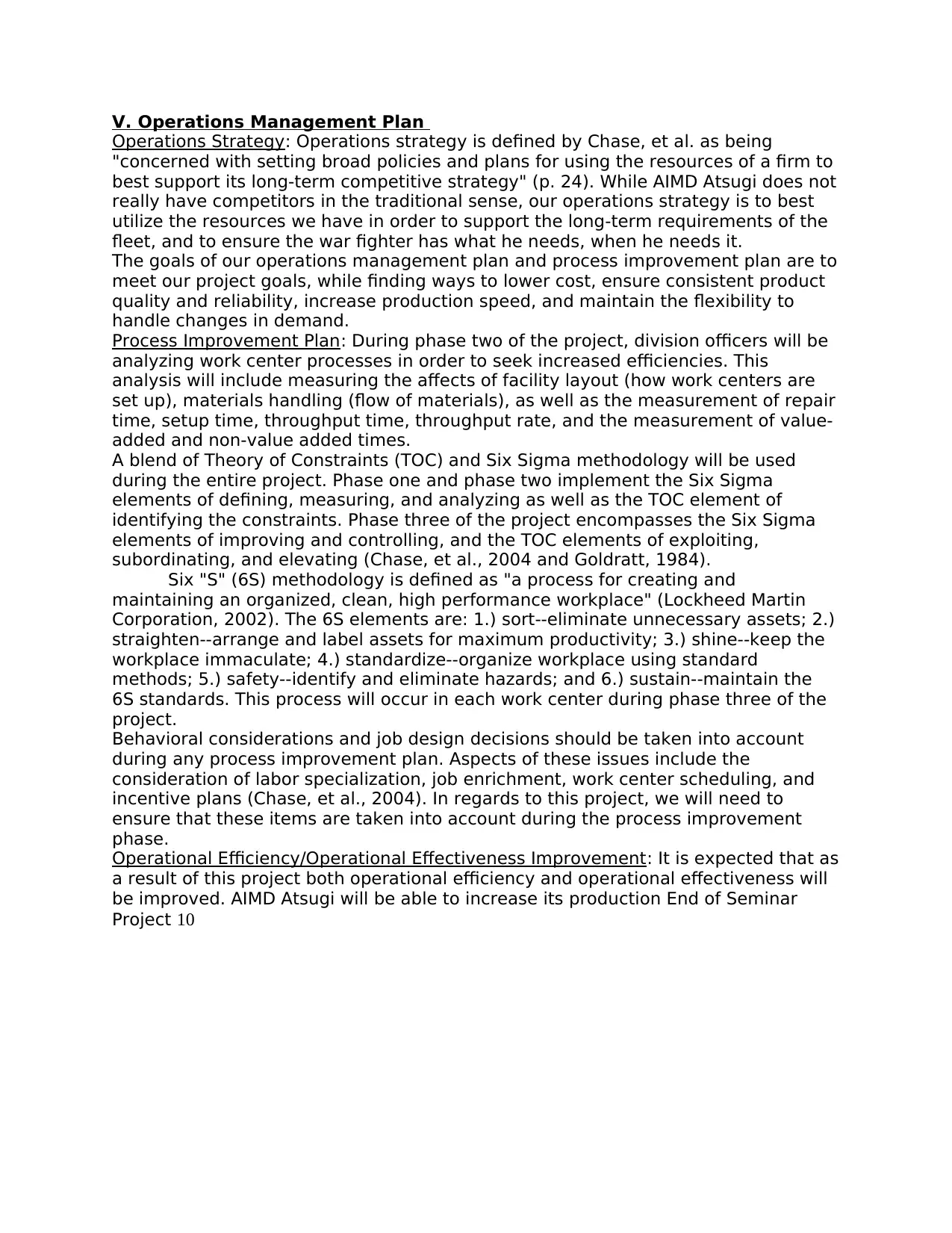
V. Operations Management Plan
Operations Strategy: Operations strategy is defined by Chase, et al. as being
"concerned with setting broad policies and plans for using the resources of a firm to
best support its long-term competitive strategy" (p. 24). While AIMD Atsugi does not
really have competitors in the traditional sense, our operations strategy is to best
utilize the resources we have in order to support the long-term requirements of the
fleet, and to ensure the war fighter has what he needs, when he needs it.
The goals of our operations management plan and process improvement plan are to
meet our project goals, while finding ways to lower cost, ensure consistent product
quality and reliability, increase production speed, and maintain the flexibility to
handle changes in demand.
Process Improvement Plan: During phase two of the project, division officers will be
analyzing work center processes in order to seek increased efficiencies. This
analysis will include measuring the affects of facility layout (how work centers are
set up), materials handling (flow of materials), as well as the measurement of repair
time, setup time, throughput time, throughput rate, and the measurement of value-
added and non-value added times.
A blend of Theory of Constraints (TOC) and Six Sigma methodology will be used
during the entire project. Phase one and phase two implement the Six Sigma
elements of defining, measuring, and analyzing as well as the TOC element of
identifying the constraints. Phase three of the project encompasses the Six Sigma
elements of improving and controlling, and the TOC elements of exploiting,
subordinating, and elevating (Chase, et al., 2004 and Goldratt, 1984).
Six "S" (6S) methodology is defined as "a process for creating and
maintaining an organized, clean, high performance workplace" (Lockheed Martin
Corporation, 2002). The 6S elements are: 1.) sort--eliminate unnecessary assets; 2.)
straighten--arrange and label assets for maximum productivity; 3.) shine--keep the
workplace immaculate; 4.) standardize--organize workplace using standard
methods; 5.) safety--identify and eliminate hazards; and 6.) sustain--maintain the
6S standards. This process will occur in each work center during phase three of the
project.
Behavioral considerations and job design decisions should be taken into account
during any process improvement plan. Aspects of these issues include the
consideration of labor specialization, job enrichment, work center scheduling, and
incentive plans (Chase, et al., 2004). In regards to this project, we will need to
ensure that these items are taken into account during the process improvement
phase.
Operational Efficiency/Operational Effectiveness Improvement: It is expected that as
a result of this project both operational efficiency and operational effectiveness will
be improved. AIMD Atsugi will be able to increase its production End of Seminar
Project 10
Operations Strategy: Operations strategy is defined by Chase, et al. as being
"concerned with setting broad policies and plans for using the resources of a firm to
best support its long-term competitive strategy" (p. 24). While AIMD Atsugi does not
really have competitors in the traditional sense, our operations strategy is to best
utilize the resources we have in order to support the long-term requirements of the
fleet, and to ensure the war fighter has what he needs, when he needs it.
The goals of our operations management plan and process improvement plan are to
meet our project goals, while finding ways to lower cost, ensure consistent product
quality and reliability, increase production speed, and maintain the flexibility to
handle changes in demand.
Process Improvement Plan: During phase two of the project, division officers will be
analyzing work center processes in order to seek increased efficiencies. This
analysis will include measuring the affects of facility layout (how work centers are
set up), materials handling (flow of materials), as well as the measurement of repair
time, setup time, throughput time, throughput rate, and the measurement of value-
added and non-value added times.
A blend of Theory of Constraints (TOC) and Six Sigma methodology will be used
during the entire project. Phase one and phase two implement the Six Sigma
elements of defining, measuring, and analyzing as well as the TOC element of
identifying the constraints. Phase three of the project encompasses the Six Sigma
elements of improving and controlling, and the TOC elements of exploiting,
subordinating, and elevating (Chase, et al., 2004 and Goldratt, 1984).
Six "S" (6S) methodology is defined as "a process for creating and
maintaining an organized, clean, high performance workplace" (Lockheed Martin
Corporation, 2002). The 6S elements are: 1.) sort--eliminate unnecessary assets; 2.)
straighten--arrange and label assets for maximum productivity; 3.) shine--keep the
workplace immaculate; 4.) standardize--organize workplace using standard
methods; 5.) safety--identify and eliminate hazards; and 6.) sustain--maintain the
6S standards. This process will occur in each work center during phase three of the
project.
Behavioral considerations and job design decisions should be taken into account
during any process improvement plan. Aspects of these issues include the
consideration of labor specialization, job enrichment, work center scheduling, and
incentive plans (Chase, et al., 2004). In regards to this project, we will need to
ensure that these items are taken into account during the process improvement
phase.
Operational Efficiency/Operational Effectiveness Improvement: It is expected that as
a result of this project both operational efficiency and operational effectiveness will
be improved. AIMD Atsugi will be able to increase its production End of Seminar
Project 10
⊘ This is a preview!⊘
Do you want full access?
Subscribe today to unlock all pages.

Trusted by 1+ million students worldwide
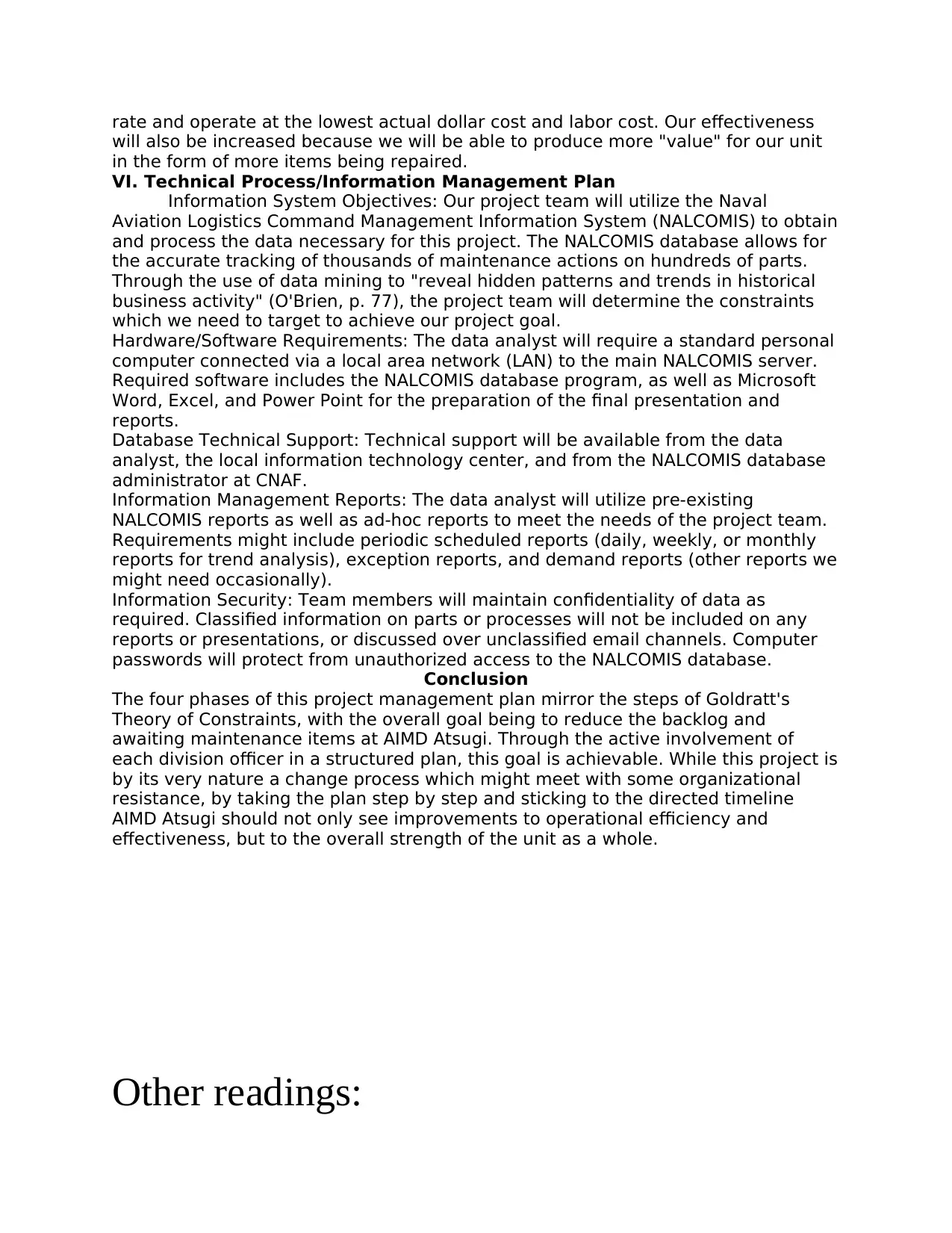
rate and operate at the lowest actual dollar cost and labor cost. Our effectiveness
will also be increased because we will be able to produce more "value" for our unit
in the form of more items being repaired.
VI. Technical Process/Information Management Plan
Information System Objectives: Our project team will utilize the Naval
Aviation Logistics Command Management Information System (NALCOMIS) to obtain
and process the data necessary for this project. The NALCOMIS database allows for
the accurate tracking of thousands of maintenance actions on hundreds of parts.
Through the use of data mining to "reveal hidden patterns and trends in historical
business activity" (O'Brien, p. 77), the project team will determine the constraints
which we need to target to achieve our project goal.
Hardware/Software Requirements: The data analyst will require a standard personal
computer connected via a local area network (LAN) to the main NALCOMIS server.
Required software includes the NALCOMIS database program, as well as Microsoft
Word, Excel, and Power Point for the preparation of the final presentation and
reports.
Database Technical Support: Technical support will be available from the data
analyst, the local information technology center, and from the NALCOMIS database
administrator at CNAF.
Information Management Reports: The data analyst will utilize pre-existing
NALCOMIS reports as well as ad-hoc reports to meet the needs of the project team.
Requirements might include periodic scheduled reports (daily, weekly, or monthly
reports for trend analysis), exception reports, and demand reports (other reports we
might need occasionally).
Information Security: Team members will maintain confidentiality of data as
required. Classified information on parts or processes will not be included on any
reports or presentations, or discussed over unclassified email channels. Computer
passwords will protect from unauthorized access to the NALCOMIS database.
Conclusion
The four phases of this project management plan mirror the steps of Goldratt's
Theory of Constraints, with the overall goal being to reduce the backlog and
awaiting maintenance items at AIMD Atsugi. Through the active involvement of
each division officer in a structured plan, this goal is achievable. While this project is
by its very nature a change process which might meet with some organizational
resistance, by taking the plan step by step and sticking to the directed timeline
AIMD Atsugi should not only see improvements to operational efficiency and
effectiveness, but to the overall strength of the unit as a whole.
Other readings:
will also be increased because we will be able to produce more "value" for our unit
in the form of more items being repaired.
VI. Technical Process/Information Management Plan
Information System Objectives: Our project team will utilize the Naval
Aviation Logistics Command Management Information System (NALCOMIS) to obtain
and process the data necessary for this project. The NALCOMIS database allows for
the accurate tracking of thousands of maintenance actions on hundreds of parts.
Through the use of data mining to "reveal hidden patterns and trends in historical
business activity" (O'Brien, p. 77), the project team will determine the constraints
which we need to target to achieve our project goal.
Hardware/Software Requirements: The data analyst will require a standard personal
computer connected via a local area network (LAN) to the main NALCOMIS server.
Required software includes the NALCOMIS database program, as well as Microsoft
Word, Excel, and Power Point for the preparation of the final presentation and
reports.
Database Technical Support: Technical support will be available from the data
analyst, the local information technology center, and from the NALCOMIS database
administrator at CNAF.
Information Management Reports: The data analyst will utilize pre-existing
NALCOMIS reports as well as ad-hoc reports to meet the needs of the project team.
Requirements might include periodic scheduled reports (daily, weekly, or monthly
reports for trend analysis), exception reports, and demand reports (other reports we
might need occasionally).
Information Security: Team members will maintain confidentiality of data as
required. Classified information on parts or processes will not be included on any
reports or presentations, or discussed over unclassified email channels. Computer
passwords will protect from unauthorized access to the NALCOMIS database.
Conclusion
The four phases of this project management plan mirror the steps of Goldratt's
Theory of Constraints, with the overall goal being to reduce the backlog and
awaiting maintenance items at AIMD Atsugi. Through the active involvement of
each division officer in a structured plan, this goal is achievable. While this project is
by its very nature a change process which might meet with some organizational
resistance, by taking the plan step by step and sticking to the directed timeline
AIMD Atsugi should not only see improvements to operational efficiency and
effectiveness, but to the overall strength of the unit as a whole.
Other readings:
Paraphrase This Document
Need a fresh take? Get an instant paraphrase of this document with our AI Paraphraser
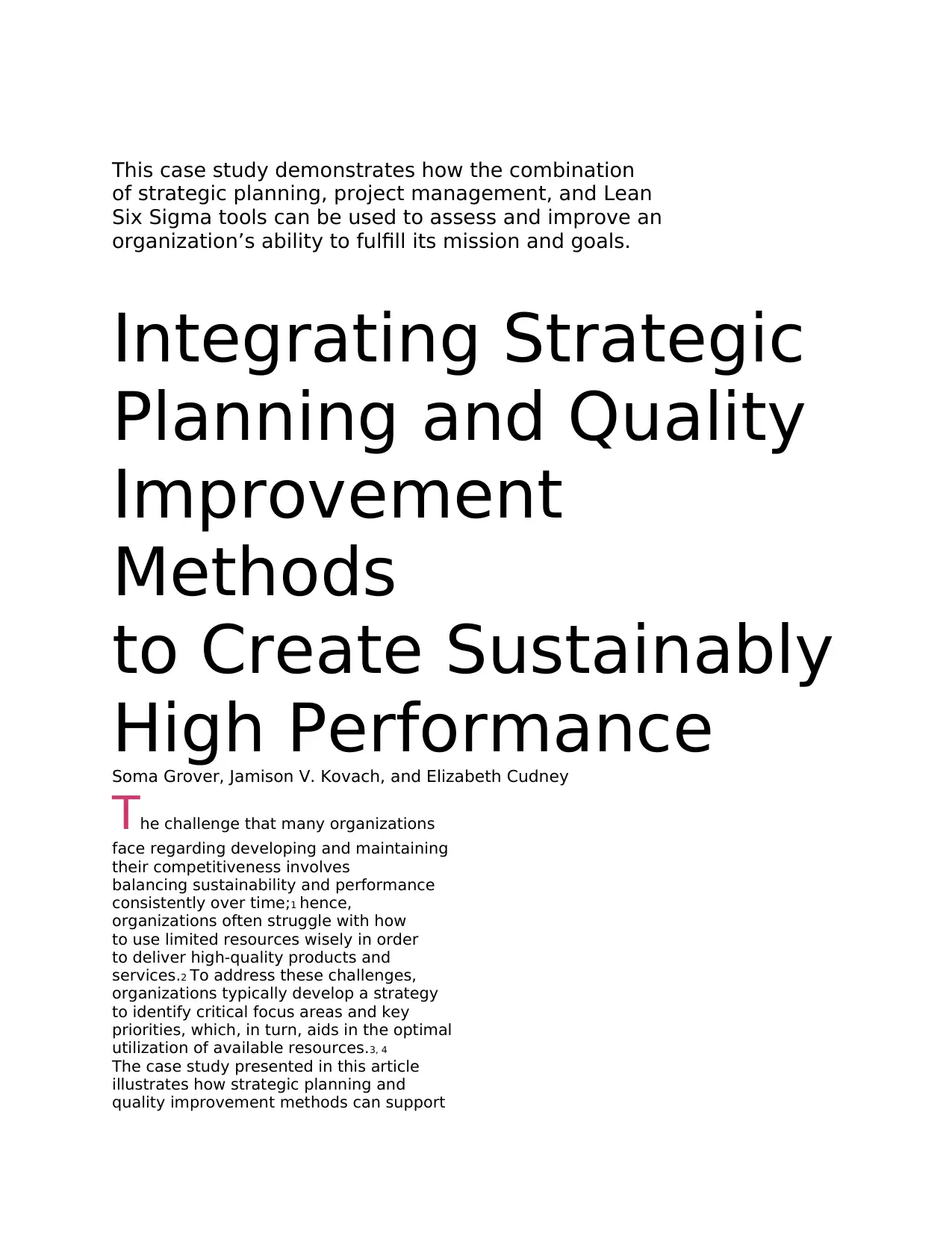
This case study demonstrates how the combination
of strategic planning, project management, and Lean
Six Sigma tools can be used to assess and improve an
organization’s ability to fulfill its mission and goals.
Integrating Strategic
Planning and Quality
Improvement
Methods
to Create Sustainably
High PerformanceSoma Grover, Jamison V. Kovach, and Elizabeth Cudney
The challenge that many organizations
face regarding developing and maintaining
their competitiveness involves
balancing sustainability and performance
consistently over time;1 hence,
organizations often struggle with how
to use limited resources wisely in order
to deliver high-quality products and
services.2 To address these challenges,
organizations typically develop a strategy
to identify critical focus areas and key
priorities, which, in turn, aids in the optimal
utilization of available resources.3, 4
The case study presented in this article
illustrates how strategic planning and
quality improvement methods can support
of strategic planning, project management, and Lean
Six Sigma tools can be used to assess and improve an
organization’s ability to fulfill its mission and goals.
Integrating Strategic
Planning and Quality
Improvement
Methods
to Create Sustainably
High PerformanceSoma Grover, Jamison V. Kovach, and Elizabeth Cudney
The challenge that many organizations
face regarding developing and maintaining
their competitiveness involves
balancing sustainability and performance
consistently over time;1 hence,
organizations often struggle with how
to use limited resources wisely in order
to deliver high-quality products and
services.2 To address these challenges,
organizations typically develop a strategy
to identify critical focus areas and key
priorities, which, in turn, aids in the optimal
utilization of available resources.3, 4
The case study presented in this article
illustrates how strategic planning and
quality improvement methods can support
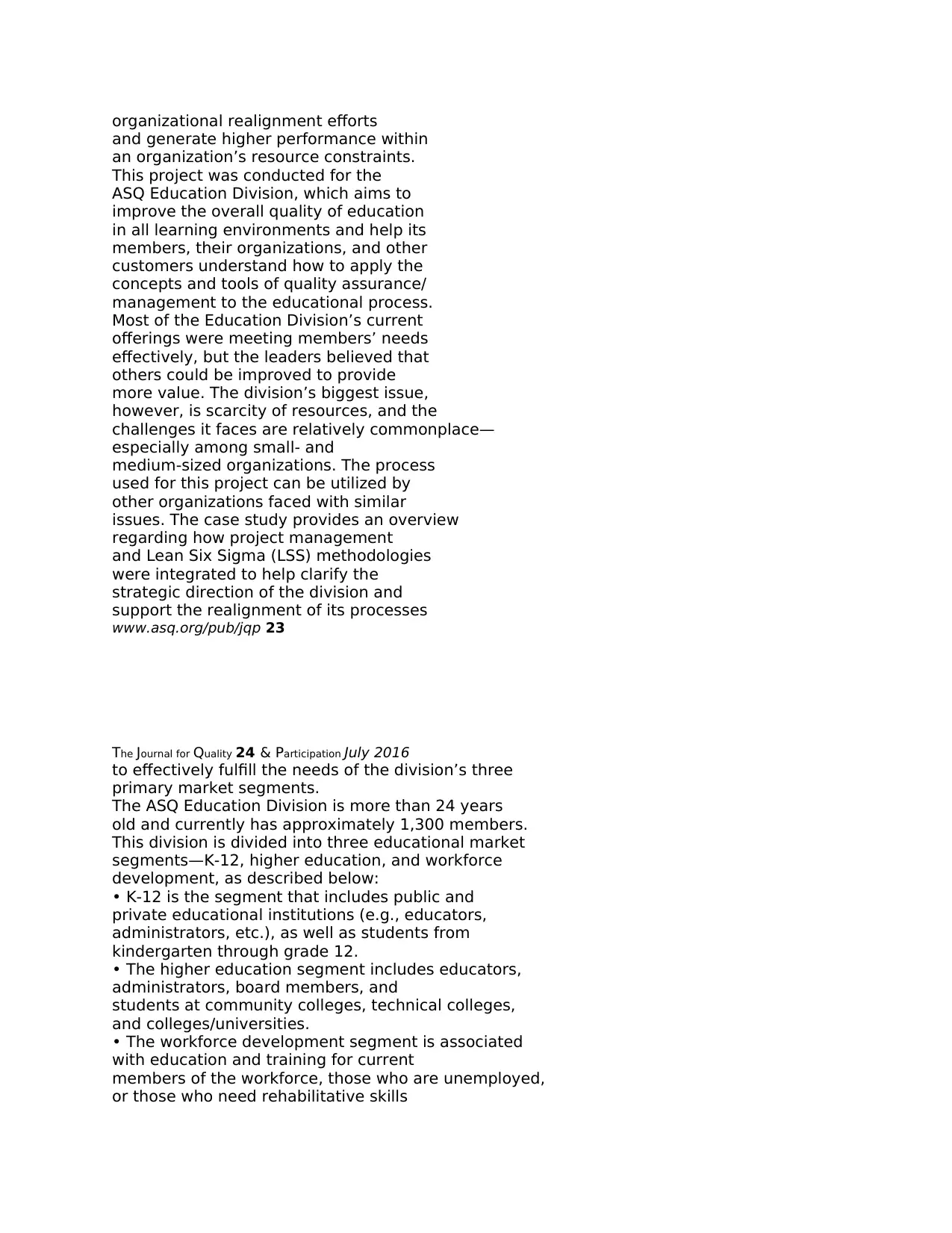
organizational realignment efforts
and generate higher performance within
an organization’s resource constraints.
This project was conducted for the
ASQ Education Division, which aims to
improve the overall quality of education
in all learning environments and help its
members, their organizations, and other
customers understand how to apply the
concepts and tools of quality assurance/
management to the educational process.
Most of the Education Division’s current
offerings were meeting members’ needs
effectively, but the leaders believed that
others could be improved to provide
more value. The division’s biggest issue,
however, is scarcity of resources, and the
challenges it faces are relatively commonplace—
especially among small- and
medium-sized organizations. The process
used for this project can be utilized by
other organizations faced with similar
issues. The case study provides an overview
regarding how project management
and Lean Six Sigma (LSS) methodologies
were integrated to help clarify the
strategic direction of the division and
support the realignment of its processes
www.asq.org/pub/jqp 23
CASE
STUDY
The Journal for Quality 24 & Participation July 2016
to effectively fulfill the needs of the division’s three
primary market segments.
The ASQ Education Division is more than 24 years
old and currently has approximately 1,300 members.
This division is divided into three educational market
segments—K-12, higher education, and workforce
development, as described below:
• K-12 is the segment that includes public and
private educational institutions (e.g., educators,
administrators, etc.), as well as students from
kindergarten through grade 12.
• The higher education segment includes educators,
administrators, board members, and
students at community colleges, technical colleges,
and colleges/universities.
• The workforce development segment is associated
with education and training for current
members of the workforce, those who are unemployed,
or those who need rehabilitative skills
and generate higher performance within
an organization’s resource constraints.
This project was conducted for the
ASQ Education Division, which aims to
improve the overall quality of education
in all learning environments and help its
members, their organizations, and other
customers understand how to apply the
concepts and tools of quality assurance/
management to the educational process.
Most of the Education Division’s current
offerings were meeting members’ needs
effectively, but the leaders believed that
others could be improved to provide
more value. The division’s biggest issue,
however, is scarcity of resources, and the
challenges it faces are relatively commonplace—
especially among small- and
medium-sized organizations. The process
used for this project can be utilized by
other organizations faced with similar
issues. The case study provides an overview
regarding how project management
and Lean Six Sigma (LSS) methodologies
were integrated to help clarify the
strategic direction of the division and
support the realignment of its processes
www.asq.org/pub/jqp 23
CASE
STUDY
The Journal for Quality 24 & Participation July 2016
to effectively fulfill the needs of the division’s three
primary market segments.
The ASQ Education Division is more than 24 years
old and currently has approximately 1,300 members.
This division is divided into three educational market
segments—K-12, higher education, and workforce
development, as described below:
• K-12 is the segment that includes public and
private educational institutions (e.g., educators,
administrators, etc.), as well as students from
kindergarten through grade 12.
• The higher education segment includes educators,
administrators, board members, and
students at community colleges, technical colleges,
and colleges/universities.
• The workforce development segment is associated
with education and training for current
members of the workforce, those who are unemployed,
or those who need rehabilitative skills
⊘ This is a preview!⊘
Do you want full access?
Subscribe today to unlock all pages.

Trusted by 1+ million students worldwide
1 out of 29
Related Documents
Your All-in-One AI-Powered Toolkit for Academic Success.
+13062052269
info@desklib.com
Available 24*7 on WhatsApp / Email
![[object Object]](/_next/static/media/star-bottom.7253800d.svg)
Unlock your academic potential
Copyright © 2020–2025 A2Z Services. All Rights Reserved. Developed and managed by ZUCOL.




